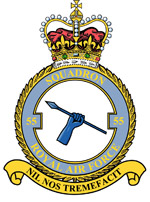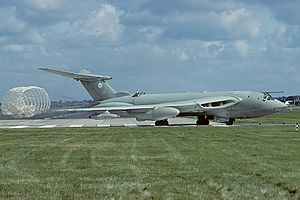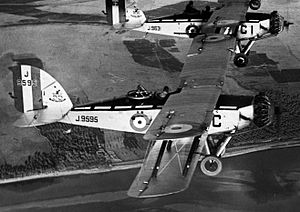No. 55 Squadron RAF facts for kids
Quick facts for kids No. 55 Squadron RAF |
|
|---|---|

Squadron badge
|
|
| Active | 27 April 1917 – 1 April 1918 (RFC) 1 April 1918 – 22 January 1920 (RAF) 1 February 1920 – 1 November 1946 1 September 1960 – 15 October 1993 15 October 1993 – 31 March 1996 1 November 1996 – 20 January 2011 |
| Country | |
| Branch | |
| Type | Flying squadron |
| Motto(s) | Latin: Nil nos tremefacit (Nothing shakes us) |
| Battle honours |
|
| Insignia | |
| Squadron badge heraldry | A cubit arm, the arm grasping a spear |
No. 55 Squadron was a special flying group in the Royal Air Force (RAF). It was first created in April 1917. This squadron played a big part in the First World War on the Western Front.
Later, it served in the Middle East during the years between the two World Wars and throughout the Second World War. During this time, No. 55 Squadron saw action over places like Iraq, Egypt, Libya, and Italy. From 1960 to 1993, the squadron flew the large Handley Page Victor aircraft. These planes were first used as bombers, then changed into tanker planes to refuel other aircraft in the air. No. 55 Squadron was the very last RAF unit to use the Victor aircraft.
After 1993, the squadron changed its role. Between 1996 and 2011, No. 55 (Reserve) Squadron used the Hawker Siddeley Dominie T.1 plane. They were based at RAF Cranwell in Lincolnshire and helped train navigators for the RAF.
Contents
History of No. 55 Squadron
Serving in the First World War
No. 55 Squadron was formed during the First World War on 27 April 1916. This happened at Castle Bromwich Aerodrome in the West Midlands. At first, it was a training unit. It used different types of planes, like the Avro 504 and the Royal Aircraft Factory B.E.2.
In January 1917, its job changed. It became a day-bomber squadron. It was the first squadron to get the new Airco DH.4 light bomber. The squadron took these planes to the Western Front in France on 6 March 1917. Their first bombing mission was on 23 April 1917. They attacked the Valenciennes railway station to help with the Battle of Arras.
The squadron moved to Azelot in June 1918. It became part of the Independent Air Force. Their main job was to fly daylight bombing missions against targets in Germany. They also did reconnaissance duties, which means flying to gather information. No. 55 Squadron developed a special way of flying. They flew in wedge shapes, dropping bombs when their leader gave the command. Their combined firepower helped protect them from enemy fighter planes. Even with many losses, 55 Squadron kept flying. They were the only day bombing squadron in the Independent Force that didn't have to stop operations due to losing too many aircrew. During the war, the squadron flew 221 bombing missions. They dropped about 141 tonnes of bombs.
After the war ended on 11 November 1918, 55 Squadron briefly delivered airmail to British forces. They returned to the United Kingdom in January 1919. The squadron officially disbanded on 22 January 1920.
Between the World Wars
The squadron started up again on 1 February 1920. This happened when No. 142 Squadron, which was based in Suez, was given the new number. They used Airco DH.9 planes. In June 1920, they started getting better Airco DH.9A planes. In July, they moved to Turkey on HMS Ark Royal. They helped the British Army protect Constantinople and the Dardanelles.
In August 1920, 55 Squadron moved to Iraq. Their job was to help keep the peace, known as 'air policing'. They arrived in Baghdad in September 1920. They used only DH.9A planes. The squadron moved to Mosul in March 1921, and then to RAF Hinaidi in May 1924. They stayed in Iraq for 19 years. Sometimes, they flew missions against rebellious tribes.
Older DH.9As were replaced by Westland Wapiti planes in February 1930. Then, in 1937, these were replaced by Vickers Vincent planes. In September of that year, they took these planes to RAF Habbaniya. In March 1939, they finally received modern monoplanes. These were twin-engined Bristol Blenheim bombers. Just before the Second World War started, they moved to Egypt.
No. 55 Squadron in the Second World War
No. 55 Squadron used its Bristol Blenheim planes to patrol shipping lanes over the Gulf of Suez. When Italy declared war in June 1940, 55 Squadron began bombing targets in Libya. On 11 June 1940, they took part in the first attack by the Royal Air Force on an Italian air base. This was at El Adem. They destroyed or damaged 18 aircraft on the ground.
In September 1941, they changed to attacking enemy ships. They continued these missions until March 1942. Then, they were taken out of action to get new Martin Baltimore planes. After that, they went back to bombing. The squadron kept helping the Eighth Army for the rest of the North African campaign.
They flew their Baltimores on bombing raids to support the Allied invasion of Sicily. They also helped with the later invasion of Italy. In October 1944, they got Boston light bombers. The squadron moved to Hassani in Greece in September 1945. In June 1946, they replaced their Bostons with de Havilland Mosquito planes. No. 55 Squadron disbanded in December 1946.
The Handley Page Victor Era

After almost fourteen years, No. 55 Squadron was reformed. This happened at RAF Honington in Suffolk on 1 September 1960. They were given the Handley Page Victor aircraft. The squadron became part of the V bomber force of RAF Bomber Command. No. 55 Squadron was the fifth Victor squadron to receive the Victor B.1A version.
In December 1964, the Vickers Valiant (another V bomber) was grounded due to metal fatigue. This meant the Royal Air Force lost its aerial refuelling tanker planes. A quick plan was made to change Victor B.1s into tankers. From May 1965, 55 Squadron moved to RAF Marham in Norfolk. They received six temporary Victor BK.1A tanker conversions. This allowed them to start refuelling other planes in the air by August 1965. By December 1966, they had replaced these temporary planes with the better Victor K.1 and K.1A tankers. They kept these until 1975, when they were replaced by the more powerful Victor K.2.
No. 55 Squadron provided air refuelling support during the Falklands War in 1982. This included the famous Operation Black Buck raids on Stanley Airfield. Along with 57 Squadron, their fellow Victor squadron, they refuelled Avro Vulcan bombers many times. This allowed the Vulcans to reach the Falkland Islands from Ascension Island. At that time, this was the longest bombing raid in history.
55 Squadron's Victors went to war again in 1991. They were sent to the Persian Gulf as part of Operation Granby. This was the United Kingdom's response to the Iraqi invasion of Kuwait. They refuelled British and other allied aircraft during Operation Desert Storm. No. 55 Squadron disbanded on 15 October 1993. They were the very last squadron to operate the Victor.
Training for the Future
On the same day that No. 55 Squadron stopped using the Victor, 241 Operational Conversion Unit at RAF Brize Norton was renamed No. 55 (Reserve) Squadron. This unit was in charge of training crews for Vickers VC10 and Lockheed TriStar planes. However, it didn't have its own aircraft.
The squadron disbanded again on 31 March 1996. It reformed at RAF Cranwell on 1 November 1996. This happened when the navigation squadron of No. 3 Flying Training School took on its identity. This squadron flew Hawker Siddeley Dominie T.1 planes. They trained people to be weapon systems officers (WSO) and weapon systems operators (WSOp).
The Dominie T.1 plane was taken out of service. The squadron disbanded when WSO and WSOp training ended on 20 January 2011.



